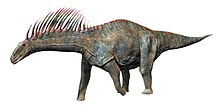Flagellicaudata: Difference between revisions
name |
clade |
||
| Line 17: | Line 17: | ||
Clade Flagellicaudata has been described in 2004, in a paper titled ''A new diplodocoid sauropod dinosaur from the Upper Jurassic Morrison Formation of Montana, USA'' by Jerald D. Harris and [[Peter Dodson]] in [[Acta Palaeontologica Polonica]]. In this paper they descibed a genus of sauropod dinosaur, ''[[Suuwassea]]''. The authors carried out phulogenetic analysis and pointed out that ''Suuwassea'', when more derived than [[Rebbachisauridae]], is in a trichotomy with tho other family belonging to Diplodocoidea (Diplodocidae and Dicraeosauridae). The new genus makes with Diplodocidae and Dicraeosauridae clade which was named Flagellicaudata. It was defined as a node-based clade consosting of the most recent common ancestor of ''[[Dicraeosaurus]]'' and ''[[Diplodocus]]'' and all of its descendants. The word "Flagellicaudata" refers to long, whip-like tails of that animals (''flagellum'' is a latin word meaning "whip" and ''cauda'' means in latin "tail"){{r|Flagellicaudata}}. |
Clade Flagellicaudata has been described in 2004, in a paper titled ''A new diplodocoid sauropod dinosaur from the Upper Jurassic Morrison Formation of Montana, USA'' by Jerald D. Harris and [[Peter Dodson]] in [[Acta Palaeontologica Polonica]]. In this paper they descibed a genus of sauropod dinosaur, ''[[Suuwassea]]''. The authors carried out phulogenetic analysis and pointed out that ''Suuwassea'', when more derived than [[Rebbachisauridae]], is in a trichotomy with tho other family belonging to Diplodocoidea (Diplodocidae and Dicraeosauridae). The new genus makes with Diplodocidae and Dicraeosauridae clade which was named Flagellicaudata. It was defined as a node-based clade consosting of the most recent common ancestor of ''[[Dicraeosaurus]]'' and ''[[Diplodocus]]'' and all of its descendants. The word "Flagellicaudata" refers to long, whip-like tails of that animals (''flagellum'' is a latin word meaning "whip" and ''cauda'' means in latin "tail"){{r|Flagellicaudata}}. |
||
Fragment of clade presented in Harris and Dodson, 2004{{r|Flagellicaudata}} |
|||
{{Clade |
|||
|label1=[[Diplodocoidea]] |
|||
|1={{Clade |
|||
|label1='''Flagellicaudata''' |
|||
|1={{Clade |
|||
|label1=[[Diplodocidae]] |
|||
|1={{Clade |
|||
|label1=[[Diplodocinae]] |
|||
|1={{Clade |
|||
|1=''[[Barosaurus]]'' |
|||
|2=''[[Diplodocus]]'' |
|||
}} |
|||
|2=''[[Apatosaurus]]'' |
|||
}} |
|||
|2=''[[Suuwassea]]'' |
|||
|label3=[[Dicraeosauridae]] |
|||
|3={{Clade |
|||
|1=''[[Dicraeosaurus]]'' |
|||
|2=''[[Amargasaurus]]'' |
|||
}} |
|||
}} |
|||
|2={{Clade |
|||
|1=''[[Rebbachisaurus]]'' |
|||
|2=''[[Nigersaurus]]'' |
|||
|3=''[[Rayososaurus]]'' |
|||
}} |
|||
}} |
|||
}} |
|||
==References== |
==References== |
||
Revision as of 17:36, 4 June 2018
| Flagellicaudata | |
|---|---|

| |
| Restoration of Amargasaurus | |
| Scientific classification | |
| Domain: | Eukaryota |
| Kingdom: | Animalia |
| Phylum: | Chordata |
| Clade: | Dinosauria |
| Clade: | Saurischia |
| Clade: | †Sauropodomorpha |
| Clade: | †Sauropoda |
| Superfamily: | †Diplodocoidea |
| Clade: | †Diplodocimorpha |
| Clade: | †Flagellicaudata |
| Families | |
Flagellicaudata – clade od Dinosauria. It belongs to Sauropoda and includes 2 families: Dicraeosauridae and Diplodocidae[1].
Clade Flagellicaudata has been described in 2004, in a paper titled A new diplodocoid sauropod dinosaur from the Upper Jurassic Morrison Formation of Montana, USA by Jerald D. Harris and Peter Dodson in Acta Palaeontologica Polonica. In this paper they descibed a genus of sauropod dinosaur, Suuwassea. The authors carried out phulogenetic analysis and pointed out that Suuwassea, when more derived than Rebbachisauridae, is in a trichotomy with tho other family belonging to Diplodocoidea (Diplodocidae and Dicraeosauridae). The new genus makes with Diplodocidae and Dicraeosauridae clade which was named Flagellicaudata. It was defined as a node-based clade consosting of the most recent common ancestor of Dicraeosaurus and Diplodocus and all of its descendants. The word "Flagellicaudata" refers to long, whip-like tails of that animals (flagellum is a latin word meaning "whip" and cauda means in latin "tail")[1].
Fragment of clade presented in Harris and Dodson, 2004[1]












